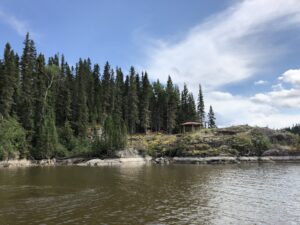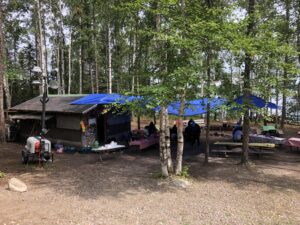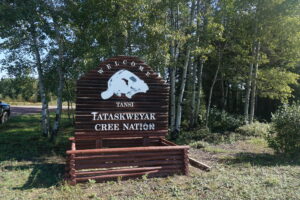By Dylan Kensick
The last week of August 2020, the Kis Kin Ha Ma Ki Win team travelled north to Nishichawayasihk Cree Nation (Nelson House) and Tataskweyak Cree Nation (Split Lake) to collaborate with the Land Guardians and to perform chemical and microbiological tests on the surrounding water systems of each community. The team first visited Nishichawayasihk and spent an afternoon acquiring footage of the waterways that have been altered from hydro development. The footage at Notigi was to show where waterfalls had been blocked and diverted to flow through one of hydro’s monitoring stations. Later, the team spent the early evening interviewing an elder to talk about the importance of land-based education and how it can help the youth and people of the community heal from the societal impacts of hydro and colonialism.

The next morning the team visited the Land Guardians office where they were greeted by 3 of the land guardians. Both teams collected water samples near an area that was of concern due to the amount of pollution that was affecting the water and land. Both teams worked together and used the Kis Kin Ha Ma Ki Win’s Wagtech mobile labs which included water quality chemical and microbiological testing. Later in the afternoon, the land learning team then went on a boat tour of the surrounding water systems to collect more samples that could be tested. One of the areas where water samples were being collected included a traditional historic site of the people of the land, it is the footprint site of a legendary spirit that is well known in many traditional stories.

On day 3 of the trip, the land learning team visited a camp of the Split Lake community which is annually held at Troy Lake. The camp had lots of people there of all ages in which many different activities took place. Swimming was popular as the water is crystal clear with fine sand beaches, the camp coordinators had set a net the night before and were able to cut up fish to enjoy a sustainable, tasty fish fry for everyone for dinner. There was bingo with prizes and gifts for people, the food was incredible, and the team was welcomed and shown amazing hospitality from everyone there. Before dinner, a couple of the camp coordinators took the team out on a boat to tour Troy Lake. They were taken to a large boulder that was mostly submerged on the other side of the lake where people had mentioned that it is a possible meteorite because it was never there the year prior. The hole and trench from a possible impact site is well noticed when inspecting the boulder and surrounding substrate. After coming back to the camp, the team had a short presentation of the land learning camps and were able to engage with the youth on different quick chemical tests.

Day 4 the land learning team visited the community of Tataskweyak Cree Nation (Split Lake) to collect water samples of different locations on the lake and river systems. The land learning team was greeted by 2 land guardians and were shown the land guardian office where we could discuss the plan of the day. The Split Lake land guardian office had a lot of artifacts that are displayed as it’s almost like a museum, most of the items were found from the surrounding land that ancestors had used. They also use the land guardian office to store the community meats as there is a new large commercial kitchen with lots of appliances and tools to use for cutting and prepping meat. The land guardians took the land learning team out on the lake to collect samples from 3 different locations: the middle of Split Lake, where the Burntwood River meets Split Lake, and where the Nelson River meets Split Lake.


